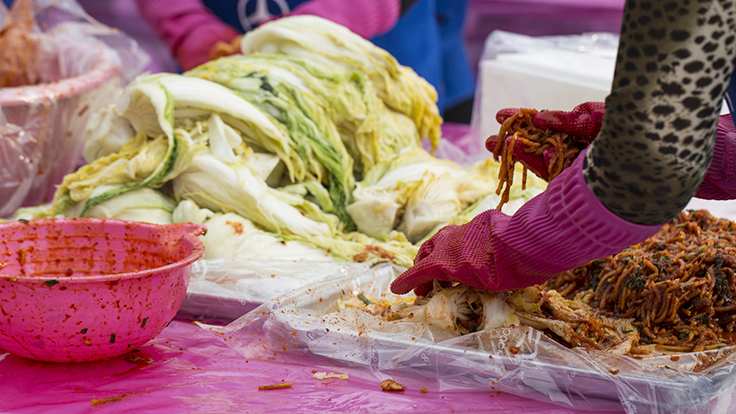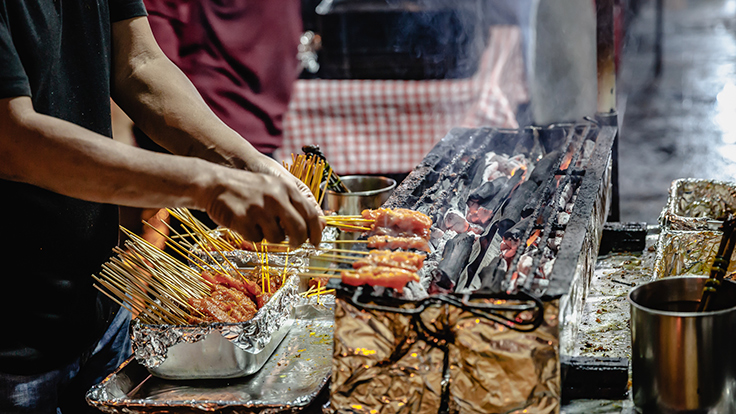Historic and natural sites around the globe have the UNESCO World Heritage designation, but how do you recognize cultural traditions? Enter UNESCO's Intangible Cultural Heritage list. This encompasses everything from tango in Argentina and Uruguay to Indonesian Wayang puppet theater. The list is updated annually and on it are a number of foods, drinks, and food customs. Here are nine to try in MICHELIN cities across the US.

Belgian Beer
Beer brewing in Belgium dates back to the ninth century, when it was made by monks in abbeys. In the 12th century, Hildegard of Bingen—a writer, composer, polymath, and Renaissance woman before the Renaissance existed—became the first to write about using hops in beer. Monks continued brewing beer in two distinct styles: Trappist—beers brewed only by Trappist monks—and Abbey—beers that were once brewed by monks but are now made by breweries. Belgium produces more than 1,000 types of beer ranging from pale blonde to dark brown, sweet to chocolatey, light to medium-full bodied, with a long finish.Drink It
- LA: Try 16-plus Belgian or Belgian-style beers at Father's Office in Downtown LA and Culver City, with a smaller menu at the Santa Monica outpost. The beer list changes daily, but look out for a Belgian Blonde brewed by Craftsman Brewing in Pasadena for Father's Office's 20th anniversary, or a Flemish sour ale from Petrus in Harelbeke, Belgium, with notes of green apple, sherry, and citrus.
Couscous
Couscous—teeny, tiny steamed balls of crushed durum wheat semolina—is a staple food of Maghrebi cuisine. The way it's produced and eaten in Algeria, Mauritania, Morocco, and Tunisia joined UNESCO's intangible heritage list in 2020. Couscous can go savory or sweet (with almonds, cinnamon, sugar, rose or orange flower water, and sometimes raisins). It's usually served with vegetables cooked in a broth or stew that can be mild to spicy and sometimes with meat (usually chicken, lamb, or mutton). In Tunisia, couscous gets its heat and burnt orange color from harissa and is often served with seafood.Eat It
- NYC: At Berber Street Food, couscous is served with tajines (veg, chicken, or merguez), with a piquant Mauritian lamb feast, and in Tunisian sardine croquettes.
- SF: Couscous at Moroccan chef-owner Mourad Lahlou's Aziza is served with cauliflower, hen of the woods mushrooms, slightly sweet, slightly smoky vadouvan, romanesco, and sunflower seeds.

Kimchi
Kimjang, the process of making kimchi, is a fundamental part of traditional Korean cuisine. It's done in both South Korea and North Korea, so it's on UNESCO's list twice. Kimchi is salted and fermented vegetables—cabbage and radish are the most common. Seasonings vary based on region and household taste, but generally include gochugaru (chili flakes), garlic, ginger, and jeotgal (salted seafood). For those who have the space, kimjang is a communal activity shared with neighbors and family, with hundreds of jars sealed and stacked, ready to be eaten throughout the year.
Eat It
- LA: At Master Ha in Koreatown, start with the remarkably fresh shrimp and crab, served plump and meaty after a light fermentation in miso. They're accompanied by an array of deliciously addictive banchan, including other more unusual kimchi like sesame-leaf.
- Chicago: One could feast on the abundant pre-meal banchan alone at Gogi—a stunning selection of kimchi, mirin-soaked fish cakes, sake-steamed black beans and more.
- NY: It’s hard to go wrong on Hahm Ji Bach’s delightful menu, but don’t miss the samgyeopsal, tender slabs of well-marinated pork belly sizzled to crispy perfection tableside for you to swaddle in crisp lettuce with paper-thin daikon radish, spicy kimchi and bright scallions; or the mit bachan, a hot clay pot with soft steamed eggs, kimchi, tofu, pickled cucumbers and spicy mackerel.
- DC: At Anju, start with banchan like Brussels sprouts and apple kimchi before devouring the perfect pork mandu.

Gastronomic Meal of the French
A leisurely, multi-course meal is an essential element of French culture. UNESCO says the meal should include pre-drinks (apéritif), "at least four courses"—starter, fish and/or meat with vegetables, cheese, dessert—and end with liqueurs (digestif). If this seems like a lot, fear not: at its core, the gastronomic meal of the French is about sharing and enjoying a meal with others.Eat It
- NY: Begin at Frenchette with brouillade, a plate filled with scrambled eggs framing a pool of Peconic snails and garlic butter. Traditional sweetbreads sport a crisp shell masking the smooth interior and are served in a savory jus studded with poached crayfish and spring peas. For dessert, a flaky mille feuille.
- DC: Darling Le Chat Noir embodies the ideal “corner” bistro with its inviting and warm ambience and classic French cooking.
- Chicago: At Chez Joël, start with frogs' legs cooked with garlic, spinach and just the right bit of butter before lingering over a perfect bowl of Gruyère-capped French onion soup. Profiteroles or crème brûlée make a divine finale.
- LA: Highlights at Papilles like plump frog legs drizzled in verdant pistou as well as the ever-so-slightly crisp red snapper sided by buttery potatoes and grilled romaine are delightful. The vacherin with layers of tangy lemon meringue and berry ice cream is textbook-perfect.

Lavash
This flatbread eaten in the South Caucasus and Western Asia makes UNESCO's list twice: once for its starring role in Armenian cuisine, and once as part of flatbread making culture in Azerbaijan, Iran, Kazakhstan, Kyrgyzstan and Turkey. Lavash is usually unleavened; a dough of wheat flour and water is kneaded and formed into balls, which are then rolled into thin layers, stretched on an oblong cushion, and cooked on the walls of a clay oven (think tandoor) for 30-60 seconds. Among the many delicious Western Asian and South Caucasus flatbreads are Turkish yufka, made only with olive oil and wheat flour, and Kyrgyz katama, a flaky, crispy swirled flatbread filled with caramelized onions.Eat It
- LA: Armenian restaurant Mini Kabob in Glendale has just three tables, with eager eaters lining up for hummus topped with Aleppo pepper for a whisper of heat, Egyptian-style falafel with green garlic, parsley and fava beans, and kebabs—charred bits of chicken thighs coupled with homemade garlic sauce are a sensory treat. Get an extra side of lavash sop up tangy sauces and juices.
- DC: Some kebabs at Turkish eatery Ottoman Taverna come wrapped in lavash, among them the char-grilled spicy beef and the chicken, both with eggplant salad, tomato sauce, and yogurt.
- NY: The chicken and beef- pork blend kebabs are wrapped in lavash at Georgian joint Chama Mama, on the border of Greenwich Village and Chelsea.

Neapolitan Pizza
It's not pizza itself that's intangible heritage but the people who prepare and bake the dough in a wood-fired oven—Neapolitan Pizzaiuolo. There's the Master Pizzaiuolo, the Pizzaiuolo, and the baker, a designation that depends on experience. What makes a pizza Neapolitan? The Associazione Verace Pizza Napoletana says the dough must be made with high protein 0 or 00 flour, kneaded by hand, and topped with either fior di latte (made from cow’s milk) or mozzarella di bufala (made from water buffalo milk), San Marzano tomatoes, basil, and extra-virgin olive oil. Into an 800℉ wood-burning oven for max. 90 seconds and you've got a pie with a chewy, puffy, slightly charred crust.
Eat It
- NY: From the oven at Una Pizza Napoletana spring glorious 12-inch Neapolitan-style pies, with fluffy edges, papery crusts, and toppings ranging from bubbly gumdrops of mozzarella di bufala and sweet tomato sauce to peppery arugula and smoked mozzarella.
- LA: Every pizza at Pizzana begins with a nod to Neapolitan tradition: start with the perfect dough and bake it into a crust that remains crisp and light right through the middle. Many pizzas include premium ingredients like San Marzano tomatoes and fior di latte, which arrives several times a week from Italy. Alternatively, deck your pie with a more creative and locally minded blend of embellishments.
- Chicago: Coalfire has its ratio down to a fine art and knows not to burden its thin and crispy crust that’s blackened and blistered in all the right places. The mortadella is a delight, with chopped garlic and gossamer slices of peppercorn-flecked sausage.
- DC: Order a half and half to explore the wide variety of Neapolitan-ish pizzas at Timber Pizza Co. The D&D’s mix of za’atar, finely diced sweet peppers and garlic chips is inventively delicious; The Hughes piles bacon, cherry tomatoes, jalapeños and basil atop a white cheese pie slathered with a subtle and sweet tomato sauce.

Nsima
This Malawian staple food is a porridge made with maize flour that's then thickened until it can be formed into solid wedges. Nsima is served with nearly everything—soups and stews, saucy meat or fish, and cooked vegetables like amaranth, pumpkin, or mustard leaves. To eat Nsima, take a bit from a larger piece, roll it into a ball, and make a small indentation to better scoop up soup or sauce. Nsima is in a family of porridges eaten widely across Sub-Saharan Africa, from ugali in the African Great Lakes region to sadza in Zimbabwe.Eat It
- DC: Expect a span of East African flavors at Swahili Village that extend beyond the Kenyan roots of chef-owner Kevin Onyona. The Swahili Basket is a great way to sample such apps as samosas and bhajias (vegetable fritters) served with a lethal pilipili sauce. Mbuzi mchuzi, a richly spiced goat stew, is best sopped up by rice pilaf or ugali; and who can turn down spinach cooked in coconut milk?

Singaporean Hawker Culture
UNESCO nails it calling Singapore's hawker centers "community dining rooms". These casual, bustling, open-air food halls have dozens, sometimes even hundreds, of stalls selling a huge variety of affordable eats. They're welcoming to everyone and draw visitors and residents from across Singapore. Think the best of a food tour, all under one roof, with satay, prata, chicken rice, laksa, nasi goreng, kaya toast...the list goes on and on. For a true hawker center, you'll have to go to Singapore—a wonderful trip for anyone who loves to eat—but you can still taste hawker-style dishes at restaurants in the US.
Eat It
- NY: If you're craving upmarket takes on satay (chicken, shrimp, scallop lamb), nasi goreng, and crab fried rice, head to Wayan in Nolita.
- Orange County: Much like a hawker center, Garlic & Chives (in Garden Grove) spans the cuisines of Southeast Asia, and you'll find a handful of dishes that would be served at a hawker center—garlic noodles with shrimp, chicken satay, seafood chao fen.

Washoku
Washoku, traditional Japanese cuisine, made UNESCO's list in 2013. It favors heavily using natural, local ingredients—rice, fish, vegetables, edible wild plants—with great respect paid to the seasons.
Eat It
- NY: The menu at hanon offers everything from simple edamame to a salad of greens, avocado, and seared octopus. Indulge in the star of the show, offered in such varieties as cold seiro; zenryufun blended with wheat bran and germ; as well as sasauchi (green noodles) made from bamboo- and barley-leaf.
- Chicago: Osaka and Hiroshima are the main styles on Gaijin's menu, which also flaunts a custom brew from Two Star Moody Tongue. While Tuesdays bring a tonkatsu feast, steamed rice with furikake, miso soup, and tsukemono are eternal hits.
- Oakland: Handmade noodles at Soba Ichi come in two varieties: 100% or 90% buckwheat, served hot or cold in dishes like tenseiro, chewy cold soba with feather-light tempura shrimp and vegetables alongside a flavorful dipping sauce. For something warmer, kamo nanban, a rich broth with tender slices of duck breast, hits the spot.
Hero image: Making couscous in Morocco. Photo © francisgonsa/iStock














